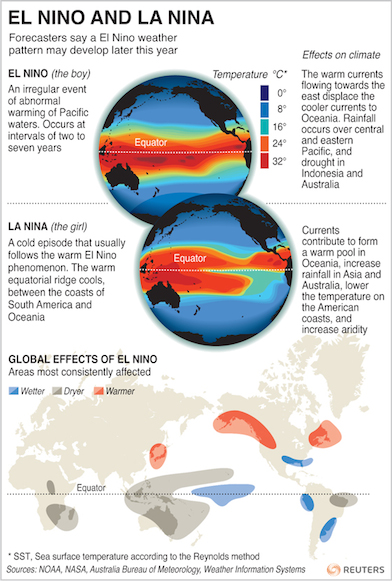Western Regional Climate Center
El Niño / Southern Oscillation (ENSO)
What is an El Niño?
El Niño is characterized by unusually warm ocean temperatures in the Equatorial Pacific, as opposed to La Niña, which is characterized by unusually cold ocean temperatures in the Equatorial Pacific. El Niño is an oscillation of the ocean-atmosphere system in the tropical Pacific having important consequences for weather around the globe.
Why does El Niño occur?
El Niño results from interaction between the surface layers of the ocean and the overlying atmosphere in tropical Pacific. It is the internal dynamics of the coupled ocean-atmosphere system that determine the onset and termination of El Niño events. The physical processes are complicated, but they involve unstable air-sea interaction and planetary scale oceanic waves. The system oscillates between warm (El Niño) to neutral (or cold) conditions with a natural periodicity of roughly 3-4 years.
What is ENSO (El Niño / Southern Oscillation)?
ENSO stands for El Niño / Southern Oscillation. The ENSO cycle refers to the coherent and sometimes very strong year-to-year variations in sea-surface temperatures, convective rainfall, surface air pressure, and atmospheric circulation that occur across the equatorial Pacific Ocean. El Niño and La Niña represent opposite extremes in the ENSO cycle.

El Niño Information
- El Niño Impacts and Outlook – November 2018
- El Niño Impacts and Outlook – September 2015
- El Niño Impacts and Outlook – October 2014
- ENSO Climate Risk & Risk Maps
- SOI – Precipitation Relationships
- ENSO FAQ (WRCC)
- Climate Prediction Center – ENSO Information Page
- Climate Prediction Center – The ENSO Cycle
- Climate Predication Center – ENSO Discussion
- Climate Prediction Center – El Niño / La Niña Home Page
- Climate Predication Center – List of El Niño / La Niña years
- Earth Systems Research Labratory – ENSO Information Page
- Earth Systems Research Labratory – ENSO Latest Predictions
- Pacific Marine Environmental Laboratory – El Niño Theme Page
- NOAA / NCDC – El Niño Discussion
- NOAA Observation Sites
- Golden Gate Weather Service – ENSO Resource Page
- Golden Gate Weather Service – The Myths and Realities of Niño